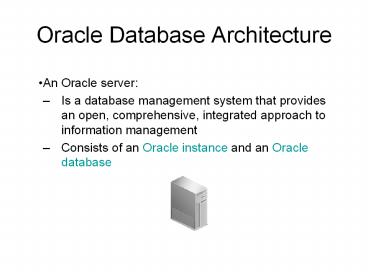Oracle Database Architecture - PowerPoint PPT Presentation
1 / 17
Title:
Oracle Database Architecture
Description:
Oracle Database Architecture An Oracle server: Is a database management system that provides an open, comprehensive, integrated approach to information management – PowerPoint PPT presentation
Number of Views:400
Avg rating:3.0/5.0
Title: Oracle Database Architecture
1
Oracle Database Architecture
- An Oracle server
- Is a database management system that provides an
open, comprehensive, integrated approach to
information management - Consists of an Oracle instance and an Oracle
database
2
Database Structures
Memory structures
Instance
Process structures
Database files
Storage structures
3
Physical Database Structure .
- Online redo log files
- Data files
Control files
- Parameter file
- Archive log files
- Backup files
- Password file
- Alert and trace log files
4
(No Transcript)
5
Data Dictionary Views
Who CanQuery Contents Subset of Notes
DBA_ DBA Everything N/A May have additional columns meant for DBA use only
ALL_ Everyone Everything that the user has privileges to see DBA_ views Includes users own objects
USER_ Everyone Everything that the user owns ALL_ views Is usually the same as ALL_ except for the missing OWNER column. Some views have abbreviated names as PUBLIC synonyms.
6
Data Dictionary Usage Examples
SELECT table_name, tablespace_name FROM
user_tables
a
SELECT sequence_name, min_value, max_value,
increment_by FROM all_sequences WHERE
sequence_owner IN ('MDSYS','XDB')
b
SELECT USERNAME, ACCOUNT_STATUS FROM dba_users
WHERE ACCOUNT_STATUS 'OPEN'
c
DESCRIBE dba_indexes
d
7
What Is a Schema?
owns
HR schema
HR user
8
Schema Objects
- In Oracle Database, a database schema is a
collection of logical data structures, or schema
objects. A database schema is owned by a database
user and has the same name as the user name.
9
Accessing Schema Objects
10
Tables
- CREATE TABLE dept
- (deptno NUMBER(2), dname VARCHAR2(42), loc
VARCHAR2(39)) - SELECT owner, table_name, num_rows
- FROM DBA_TABLES
- WHERE owner'NIKOVITS' AND table_name'DEPT'
- (!) ANALYZE TABLE DEPT COMPUTE STATISTICS
- (!) ANALYZE TABLE DEPT DELETE STATISTICS
11
Tables
- CREATE TABLE dept
- (deptno NUMBER(2), dname VARCHAR2(42), loc
VARCHAR2(39)) - SELECT column_id, column_name, data_type,
data_length, data_precision,
data_scale - FROM DBA_TAB_COLUMNS
- WHERE owner'NIKOVITS' AND table_name'DEPT'
12
Views
- CREATE VIEW v1 AS
- SELECT deptno, AVG(sal) AvgSal FROM emp GROUP BY
deptno - SELECT view_name, text
- FROM DBA_VIEWS
- WHERE owner'NIKOVITS' AND view_name'V1'
13
Synonyms
- CREATE SYNONYM syn1 FOR v1
- SELECT FROM DBA_SYNONYMS
- WHERE owner'NIKOVITS' AND synonym_name'SYN1'
- SELECT FROM syn1 WHERE deptno gt 10
14
Sequences
- A sequence is a mechanism for automatically
generating integers that follow a pattern. - A sequence has a name, which ishow it is
referenced when the nextvalue is requested. - A sequence is not associated withany particular
table or column. - The progression can be ascending ordescending.
- The interval between numbers can be of any size.
- A sequence can cycle when a limit is reached.
1
2
3
4
5
15
Sequences
- CREATE SEQUENCE seq1
- MINVALUE 1 MAXVALUE 100 INCREMENT BY 5
- START WITH 50 CYCLE
- SELECT FROM DBA_SEQUENCES
- WHERE sequence_name'SEQ1'
16
Using a Sequence
- Next value from sequence
- INSERT INTO dept VALUES(seq1.NEXTVAL, 'IT',
'Budapest') - Current value from sequence
- INSERT INTO emp(deptno, empno, ename, job, sal)
- VALUES(seq1.CURRVAL, 1, 'Tailor', 'SALESMAN',
100) - Current value from sequence
- INSERT INTO emp(deptno, empno, ename, job, sal)
- VALUES(seq1.CURRVAL, 2, 'Sailor', 'SALESMAN',
200)
17
ANY Object
- SELECT owner, object_name, object_id, object_type
- FROM DBA_OBJECTS
- WHERE owner'NIKOVITS and created gt sysdate - 1

